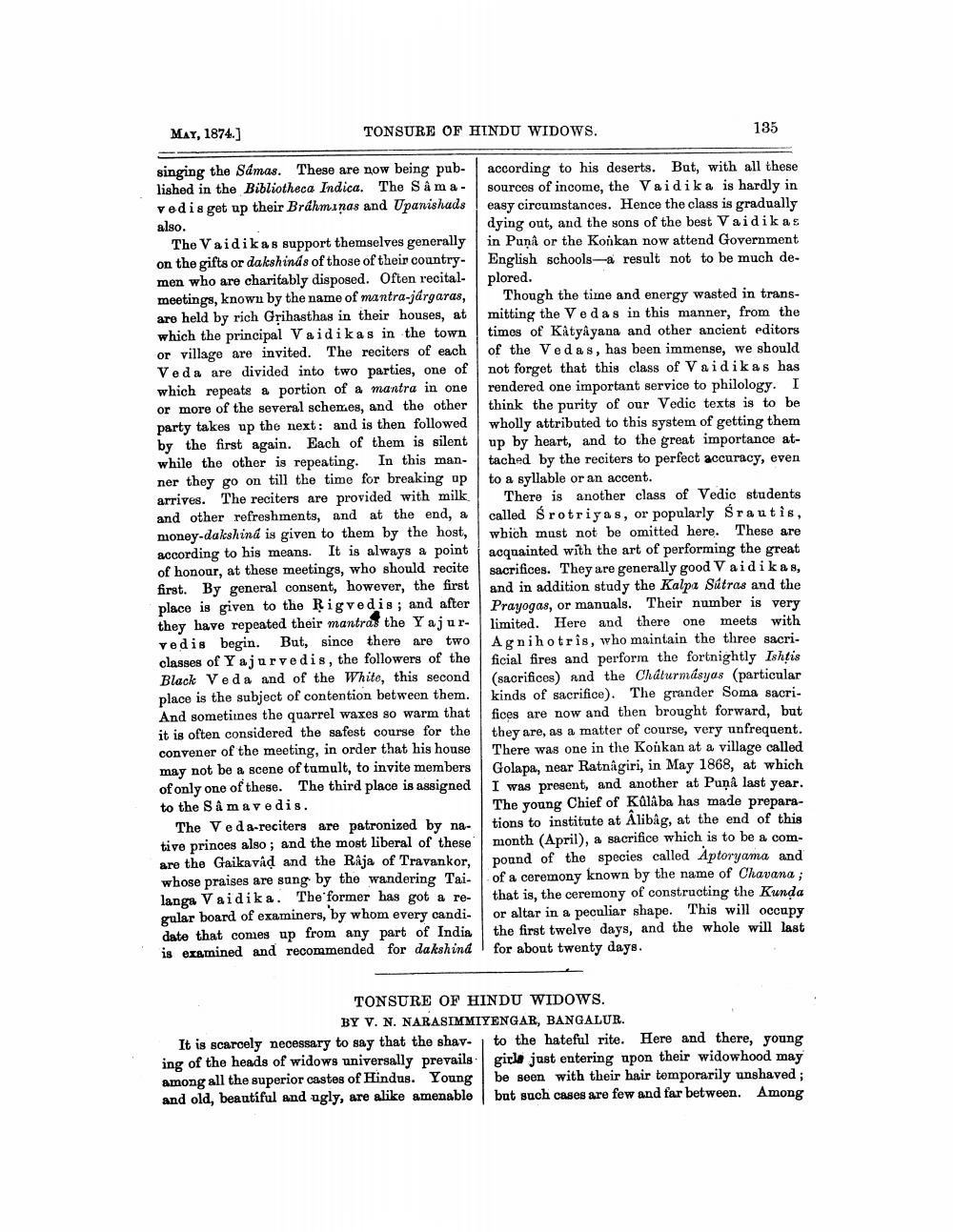________________
TONSURE OF HINDU WIDOWS.
MAY, 1874.]
singing the Samas. These are now being published in the Bibliotheca Indica. The Sâm avedis get up their Brahminas and Upanishads also.
The Vaidika s support themselves generally on the gifts or dakshinds of those of their countrymen who are charitably disposed. Often recitalmeetings, known by the name of mantra-járgaras, are held by rich Grihasthas in their houses, at which the principal Vaidikas in the town or village are invited. The reciters of each Veda are divided into two parties, one of which repeats a portion of a mantra in one or more of the several schemes, and the other party takes up the next: and is then followed by the first again. Each of them is silent while the other is repeating. In this manner they go on till the time for breaking up arrives. The reciters are provided with milk and other refreshments, and at the end, a money-dakshina is given to them by the host, according to his means. It is always a point of honour, at these meetings, who should recite first. By general consent, however, the first place is given to the Rigvedis; and after they have repeated their mantras the Yajur vedis begin. But, since there are two classes of Yajurvedis, the followers of the Black Veda and of the White, this second place is the subject of contention between them. And sometimes the quarrel waxes so warm that it is often considered the safest course for the convener of the meeting, in order that his house may not be a scene of tumult, to invite members of only one of these. The third place is assigned to the Sâm a vedis.
The Veda-reciters are patronized by native princes also; and the most liberal of these are the Gaikavad and the Raja of Travankor, whose praises are sung by the wandering Tailanga Vaidika. The former has got a regular board of examiners, by whom every candidate that comes up from any part of India is examined and recommended for dakshind
It is scarcely necessary to say that the shaving of the heads of widows universally prevails among all the superior castes of Hindus. Young and old, beautiful and ugly, are alike amenable
135
according to his deserts. But, with all these sources of income, the Vaidika is hardly in easy circumstances. Hence the class is gradually dying out, and the sons of the best Vaidikas in Punâ or the Konkan now attend Government English schools-a result not to be much deplored.
Though the time and energy wasted in transmitting the Vedas in this manner, from the times of Katyayana and other ancient editors of the Vedas, has been immense, we should not forget that this class of Vaidikas has rendered one important service to philology. I think the purity of our Vedic texts is to be wholly attributed to this system of getting them up by heart, and to the great importance attached by the reciters to perfect accuracy, even to a syllable or an accent.
TONSURE OF HINDU WIDOWS. BY V. N. NARASIMMIYENGAR, BANGALUR.
There is another class of Vedic students called Śrotriyas, or popularly Śrautis, which must not be omitted here. These are acquainted with the art of performing the great sacrifices. They are generally good Vaidikas, and in addition study the Kalpa Sutras and the Prayogas, or manuals. Their number is very limited. Here and there one meets with Agnihotris, who maintain the three sacrificial fires and perform the fortnightly Ishtis (sacrifices) and the Châturmásyas (particular kinds of sacrifice). The grander Soma sacrifices are now and then brought forward, but they are, as a matter of course, very unfrequent. There was one in the Konkan at a village called Golapa, near Ratnagiri, in May 1868, at which I was present, and another at Punâ last year. The young Chief of Kûlâba has made preparations to institute at Âlibâg, at the end of this month (April), a sacrifice which is to be a compound of the species called Aptoryama and of a ceremony known by the name of Chavana; that is, the ceremony of constructing the Kunda or altar in a peculiar shape. This will occupy the first twelve days, and the whole will last for about twenty days.
to the hateful rite. Here and there, young girls just entering upon their widowhood may be seen with their hair temporarily unshaved; but such cases are few and far between. Among




